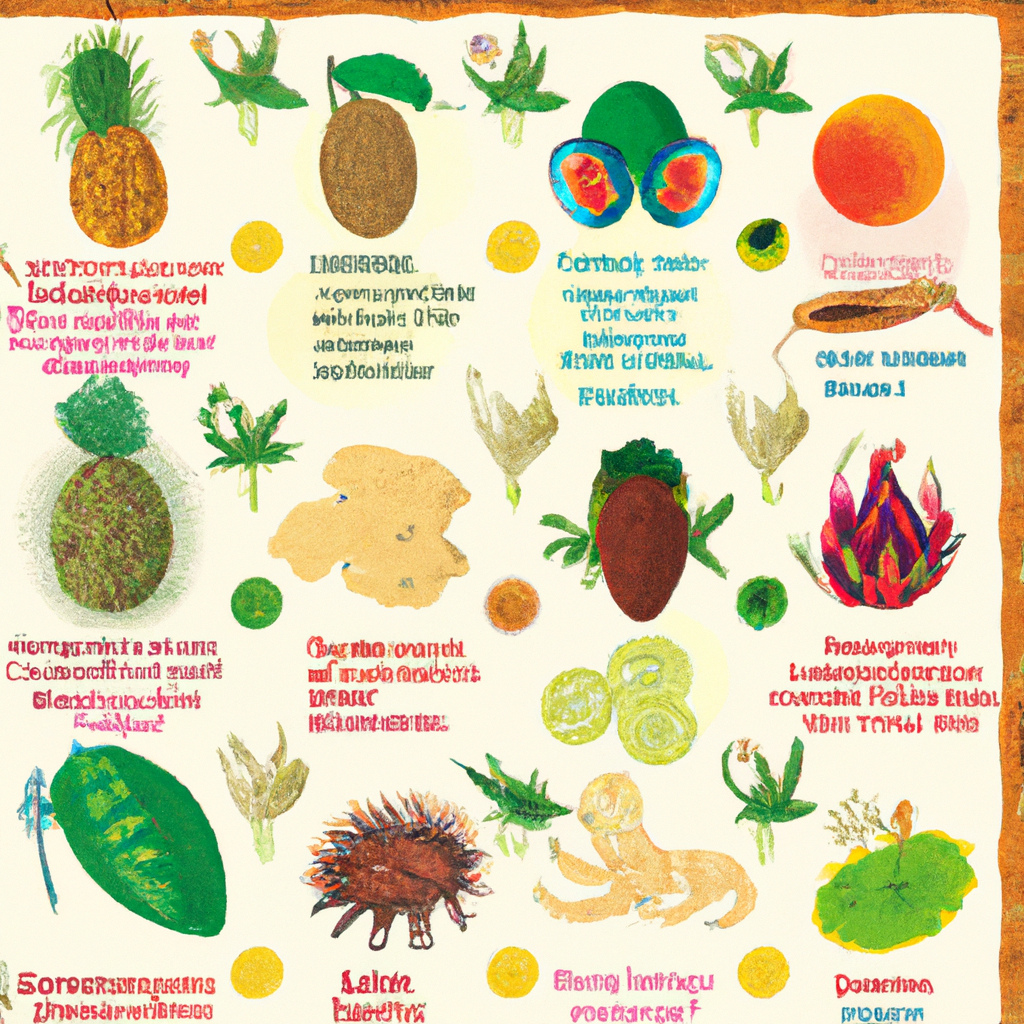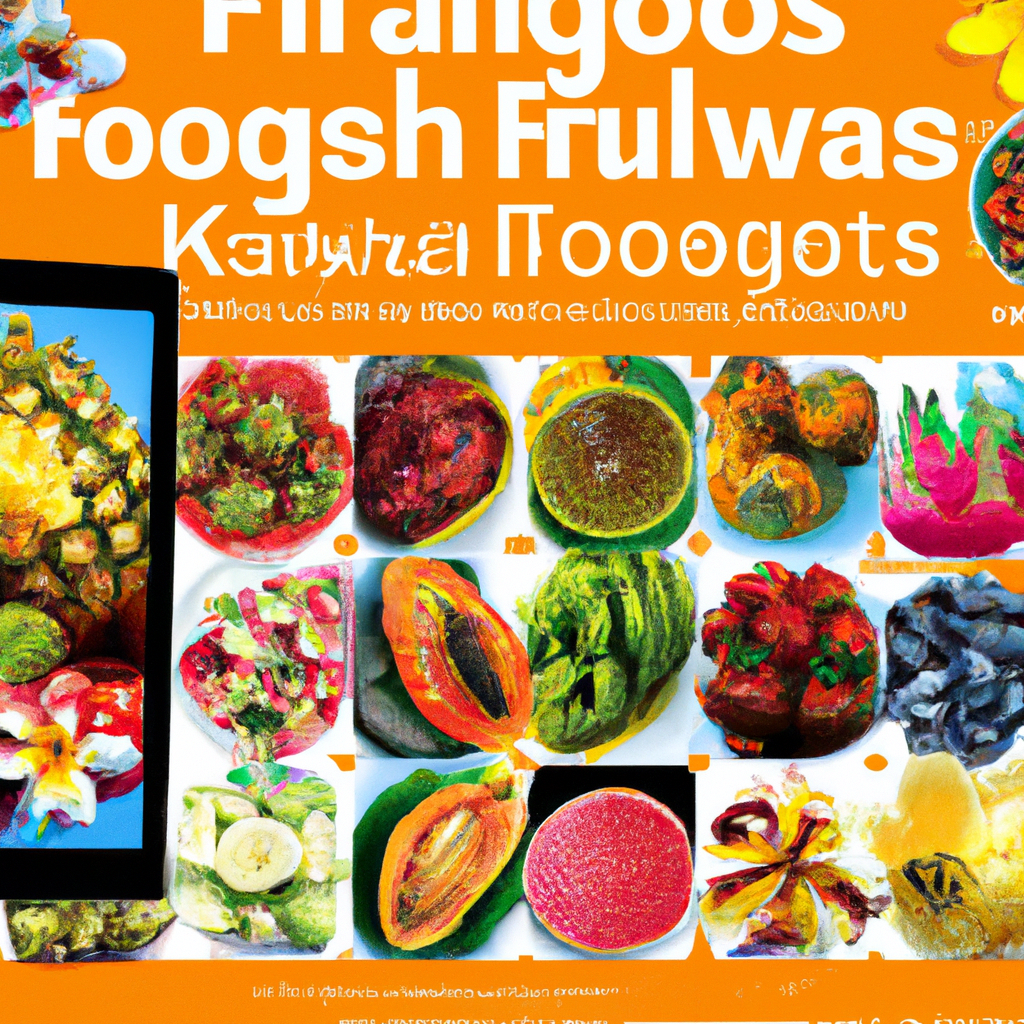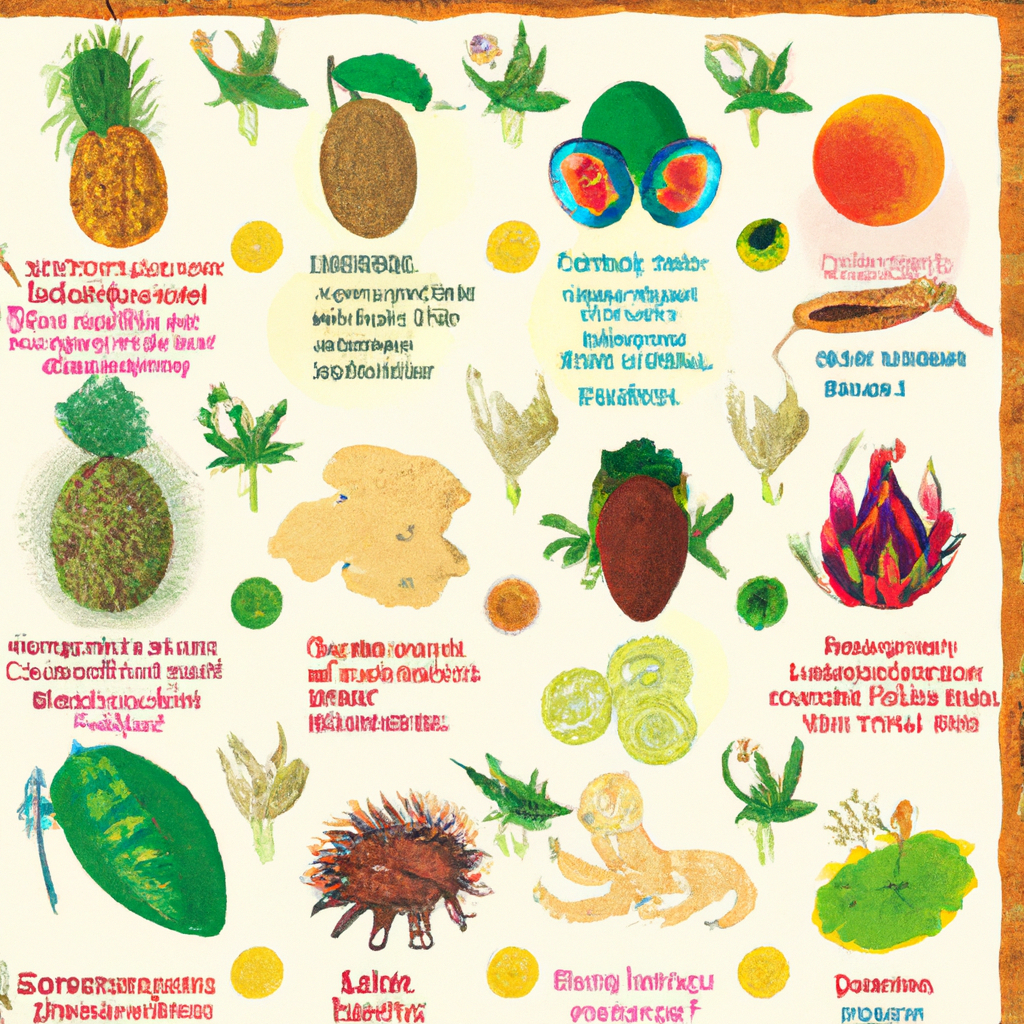Embark on a delightful culinary adventure as you immerse yourself in the vibrant flavors of Hawaii’s tropical fruits. From the juicy sweetness of pineapples to the exotic tang of dragon fruit, this article takes you on a mouthwatering journey through the rich and varied fruit offerings of the Hawaiian islands. Get ready to tantalize your taste buds and learn fascinating facts about these tropical delights that have become synonymous with the paradise of Hawaii.

1. Introduction
Welcome to Hawaii, where the tropical fruits are as abundant and diverse as the breathtaking landscapes. In this article, we will take you on a delightful culinary journey through the bounty of Hawaii’s tropical fruits. From the rich botanical diversity to the cultural significance, we will explore the exotic flavors and traditional Hawaiian fruit dishes. Additionally, we will delve into the fusion of Hawaiian and international cuisines, discover cooking techniques and tips, and understand the role of tropical fruits in Hawaiian agriculture. So grab a seat, get ready to tantalize your taste buds, and join us on this unforgettable adventure.
2. The Bounty of Hawaii’s Tropical Fruits
2.1 Botanical Diversity
Hawaii’s unique geographical location and favorable climate provide the perfect conditions for a remarkable array of tropical fruits to flourish. In fact, the islands are home to over 200 different species of fruits, each with its own distinct flavor and texture. From luscious papayas to tangy passion fruits, Hawaii’s botanical diversity offers a treasure trove of taste sensations waiting to be discovered.
2.2 Cultural Significance
Tropical fruits hold immense cultural significance in Hawaii. Native Hawaiians have long embraced these fruits as a vital part of their diet and traditional practices. They symbolize abundance, health, and the connection between the land and its people. Tropical fruits are not only delicious, but they also play an essential role in cultural ceremonies, celebrations, and even medicinal remedies. Their significance in Hawaiian culture makes them all the more fascinating to explore and appreciate.
3. Exotic Flavors of Hawaii
3.1 Papaya
One bite into a ripe papaya, and you’ll be instantly transported to a tropical paradise. The smooth, buttery texture and sweet, succulent flavor of papaya make it a true island delicacy. Whether enjoyed fresh on its own or added to smoothies and salads, papaya is a versatile fruit that is sure to delight your taste buds.
3.2 Pineapple
Known as the “king of fruits,” pineapple is one of Hawaii’s most iconic tropical fruits. With its vibrant golden color, juicy flesh, and refreshing sweetness, the taste of a ripe pineapple captures the essence of the Hawaiian spirit. Grill it, blend it into drinks, or use it as a topping for pizzas and burgers – the possibilities are endless with this tropical gem.
3.3 Mango
Mangoes bring a burst of sunshine to any dish with their mouthwatering tropical flavors. The smooth, juicy flesh of a ripe mango is a true delight to savor. Whether you enjoy it on its own, blend it into smoothies, or add it to savory dishes for a touch of sweetness, mangoes are a true tropical treat.
3.4 Passion Fruit
Passion fruit, with its wrinkled purple exterior and juicy, tart-sweet pulp, is a true tropical sensation. The tangy flavor of this exotic fruit is a perfect complement to desserts, cocktails, and sauces. Once you taste the unique tanginess of passion fruit, you’ll find yourself craving its refreshing burst of flavor again and again.
3.5 Guava
With its tropical aroma and vibrant pink flesh, guava is a fruit that captures the essence of paradise. The sweet, tropical flavor of guava can be enjoyed in its natural state, juiced, or used in various culinary creations. From jams to pastries, guava brings a delightful twist to both sweet and savory dishes.
3.6 Lychee
Lychee, with its rough, red exterior and translucent white flesh, is a tropical delicacy like no other. Its sweet and floral flavor offers a delightful burst of freshness. Whether eaten on its own or used as a garnish for cocktails and desserts, lychee adds a touch of elegance and exoticism to any culinary creation.
3.7 Coconut
Coconuts are the epitome of tropical paradise, with their refreshing water and creamy white flesh. From coconut water to coconut milk and coconut oil, every part of this versatile fruit is used in Hawaiian cuisine. The sweet and nutty flavor of coconut enhances both sweet and savory dishes, making it a staple in tropical cooking.
3.8 Breadfruit
Breadfruit, a relative of the jackfruit, is a large, starchy fruit with a mild and slightly nutty flavor. It is often cooked and used as a substitute for potatoes or bread. Whether roasted, steamed, or fried, breadfruit adds a unique texture and flavor to a variety of dishes, making it a beloved ingredient in Hawaiian cuisine.
3.9 Dragon Fruit
Known for its vibrant pink or yellow exterior and speckled white flesh, dragon fruit is as beautiful as it is delicious. This fruit boasts a subtle sweetness with a hint of tartness, making it a refreshing addition to smoothies, salads, and desserts. Its striking appearance and unique taste make it a favorite among tropical fruit enthusiasts.
4. Traditional Hawaiian Fruit Dishes
4.1 Poke Bowls with Tropical Fruits
Poke bowls, a traditional Hawaiian dish, have gained popularity worldwide for their vibrant flavors and healthy ingredients. One way to elevate the flavors of a poke bowl is by incorporating tropical fruits. The combination of diced fresh fish, fragrant rice, and juicy chunks of pineapple, mango, and papaya creates a medley of flavors that will transport you straight to the shores of Hawaii.
4.2 Lomi Lomi Salmon with Mango
Lomi lomi salmon is a traditional Hawaiian dish that showcases the simplicity and freshness of local ingredients. The dish consists of diced salmon, tomatoes, onions, and salt, all mixed together to create a delightful and flavorful salad. Adding juicy cubes of mango to the mix takes this dish to a whole new level of tropical decadence, combining the sweetness of mango with the savory and slightly tangy notes of salmon.
4.3 Haupia with Banana
Haupia, a traditional Hawaiian coconut milk-based dessert, is known for its smooth and creamy texture. By infusing the sweet flavor of mashed bananas into the haupia, you create a tropical twist on this beloved Hawaiian dessert. The combination of coconut and banana creates a luscious and tropical treat that is perfect for satisfying your sweet tooth.
4.4 Poi with Passion Fruit
Poi, a staple in traditional Hawaiian cuisine, is made from taro root and has a slightly tangy and earthy flavor. This starchy dish is often eaten as a side or used as a base for other dishes. To add a burst of tropical flavor to poi, passion fruit can be used as a topping or mixed into the poi itself. The tanginess of the passion fruit perfectly complements the mild taste of the poi, creating a delightful fusion of flavors.

5. Fusion Cuisine: Combining Hawaiian and International
5.1 Tropical Fruit Salsa
One of the joys of Hawaiian cuisine is the combination of tropical fruits with international flavors. A tropical fruit salsa, made with a medley of diced fruits such as pineapple, mango, and papaya, along with onions, cilantro, and lime juice, adds a burst of freshness and vibrant flavors to any dish. This versatile salsa can be paired with grilled fish, roasted chicken, or enjoyed on its own with crispy tortilla chips.
5.2 Mango Sticky Rice
Originating from Thailand, mango sticky rice has become a popular dessert in Hawaii due to its harmonious blend of flavors and textures. The combination of sweet, sticky rice infused with aromatic coconut milk, and topped with slices of ripe mango, creates a heavenly dessert that showcases the best of both Hawaiian and Thai cuisines.
5.3 Coconut Banana Pancakes
Incorporating tropical fruits into breakfast is a delightful way to start the day. Coconut banana pancakes are a perfect example of this fusion. By adding shredded coconut and chunks of ripe banana to the pancake batter, you create a tropical twist on a classic breakfast favorite. Top it off with a drizzle of coconut syrup or a sprinkle of toasted coconut flakes for an extra touch of paradise.
5.4 Pineapple Curry
While curry may not be traditionally associated with Hawaii, the fusion of pineapple with curry creates a mouthwatering dish that is uniquely Hawaiian. The natural sweetness of pineapple balances the heat and spices of the curry, resulting in a flavorful and aromatic dish. Whether made with chicken, shrimp, or vegetables, pineapple curry captures the essence of Hawaii’s culinary creativity.
5.5 Passion Fruit Cheesecake
To satisfy your sweet tooth, indulge in a slice of passion fruit cheesecake. By infusing the tangy and aromatic flavor of passion fruit into a creamy cheesecake filling, you create a dessert that is both refreshing and indulgent. The vibrant flavor of passion fruit pairs perfectly with the smooth and velvety texture of the cheesecake, creating a tropical dessert that is sure to impress.
6. Cooking Techniques and Tips
6.1 Selecting Ripe Tropical Fruits
When selecting tropical fruits, look for vibrant colors, fragrant aromas, and slightly firm textures. Pineapples should have a sweet scent and a golden color. Papayas should yield slightly when pressed and have a sweet aroma. Mangoes should be fragrant and have a slight give when gently squeezed. Passion fruits should have a wrinkled skin and a fragrant aroma. By using your senses to assess the ripeness of these fruits, you’ll ensure that every bite is bursting with flavor.
6.2 Preparing Tropical Fruits for Cooking
Different tropical fruits require different preparation methods. Pineapples and mangoes should be peeled and sliced, removing the tough outer skin and pit, respectively. Papayas can be halved, seeds scooped out, and the flesh can be eaten with a spoon. Passion fruits should be cut in half, and the pulp and seeds can be scooped out and used in various dishes. Taking the time to learn the specific preparation techniques for each fruit will enhance your culinary experience.
6.3 Enhancing Flavor with Tropical Fruits
Tropical fruits can be used to enhance the flavor of both sweet and savory dishes. Their natural sweetness and vibrant flavors add depth and complexity to a variety of recipes. Puree papaya and use it as a marinade for grilled meats. Add diced pineapple to your stir-fries for a burst of sweetness. Use mangoes and passion fruits to create tangy salad dressings. The options are endless when it comes to using tropical fruits to elevate your culinary creations.
7. The Role of Tropical Fruits in Hawaiian Agriculture
7.1 Economic Importance
Tropical fruits play a significant role in Hawaii’s agricultural industry. The cultivation, processing, and export of these fruits contribute to the local economy and provide job opportunities for many. The demand for Hawaiian tropical fruits, both domestically and internationally, continues to grow, showcasing the economic importance and potential of this agricultural sector.
7.2 Sustainable Farming Practices
Hawaii’s agricultural industry recognizes the need for sustainable farming practices to preserve the delicate ecosystems of the islands. Farmers and growers are implementing environmentally friendly techniques such as organic farming, crop rotation, and water conservation methods. By practicing sustainable farming, they ensure the long-term viability of the tropical fruit industry while preserving the natural beauty and resources of the islands.
8. A Taste of Paradise: Tropical Fruit Tours in Hawaii
8.1 Oahu Fruit Loop
Embark on the Oahu Fruit Loop tour and immerse yourself in the world of tropical fruits. This guided tour takes you to various farms and plantations where you can sample a wide range of fruits, learn about their cultivation, and even pick your own tropical treats. From bustling pineapple farms to serene mango orchards, the Oahu Fruit Loop tour offers a unique opportunity to experience the flavors and beauty of Hawaii’s tropical fruits firsthand.
8.2 Hawaii Fruit and Agricultural Tours
For a more comprehensive tropical fruit experience, consider joining a Hawaii Fruit and Agricultural tour. These tours allow you to explore multiple islands and visit different fruit farms and plantations. You’ll have the chance to taste a variety of tropical fruits, learn about their cultivation techniques, and gain a deeper understanding of the agricultural practices that sustain the industry. With knowledgeable guides and breathtaking scenery, these tours offer an unforgettable journey through the flavors of Hawaii.
8.3 Tropical Fruit Farm Experiences
For those seeking a hands-on tropical fruit adventure, several farms in Hawaii offer immersive farm experiences. These experiences allow you to participate in the harvesting and processing of tropical fruits, learn about traditional farming techniques, and even enjoy farm-to-table meals made with freshly picked produce. Whether you’re interested in mangoes, pineapples, or a variety of exotic fruits, these farm experiences provide a unique and intimate connection with Hawaii’s tropical agriculture.
9. From Farm to Fork: Locally Sourced Tropical Fruits
9.1 Farmers’ Markets and Produce Stands
One of the best ways to support local agriculture and enjoy fresh tropical fruits is by visiting farmers’ markets and produce stands. These vibrant and bustling hubs offer an abundance of locally sourced fruits, including papayas, pineapples, mangoes, and more. By purchasing directly from these vendors, you not only ensure the highest quality and freshness but also contribute to the sustainability of Hawaii’s agricultural communities.
9.2 Supporting Local Agriculture
When dining out in Hawaii, opt for restaurants that prioritize locally sourced ingredients, including tropical fruits. By choosing establishments that support local farmers and growers, you become an active participant in the preservation and growth of Hawaii’s agricultural industry. Not only will you enjoy the freshest and most flavorful dishes, but you will also have the satisfaction of knowing that you are contributing to the sustainable future of the islands.
10. Conclusion
Exploring Hawaii’s tropical fruits is a culinary journey like no other. From the rich botanical diversity to the cultural significance, the flavors and aromas of these exotic fruits delight the senses and transport you to a tropical paradise. Whether enjoyed in traditional Hawaiian dishes, infused into fusion cuisines, or experienced on farm tours, the abundance of tropical fruits in Hawaii invites you to indulge in a taste of paradise. So let your palate be your guide as you savor the diverse and enchanting flavors of Hawaii’s tropical fruits – a truly flavorful culinary adventure awaits you.
